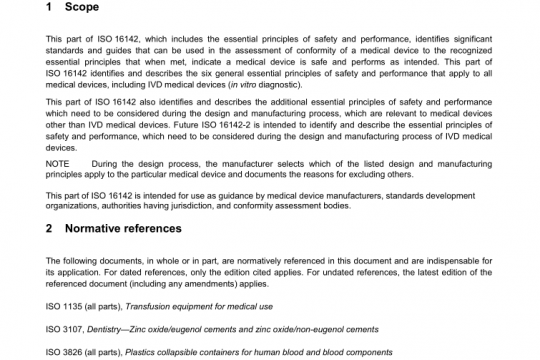AAMI TIR 45 pdf free download – Guidance on the use of AGILE practices in the development of medical device software
AAMI TIR 45 pdf free download.Guidance on the use of AGILE practices in the development of medical device software.
3 Terms and definitions
For the purposes of this document and within its scope, the following terms and definitions apply. Rather than addressing or referencing all terms/definitions applicable to both the AGILE and regulatory perspectives, only those that are significantly pertinent to multiple TIR areas and/or need explanation between competing views have been included. Defined terms appear within the body of the document in bold SMALL CAPS.
3.1
AGILE
With respect to software or product development, term that does not denote a specific methodology, approach, or practice (i.e., there is no generally accepted, specific AGILE methodology) but rather an umbrella term that is typically applied when software or product development 1) fits with the spirit of the Manifesto for AGILE Software Development, see http://www.agilemanifesto.org [8], 2) is more empirical than deterministic, and 3) is EVOLUTIONARY and frequently iterative. The AGILE Alliance, see http:llwww.agilealliance.org, describes “AGILE Software Development” in the following manner: ln the late 1990’s several methodologies began to get increasing public attention. Each had a different combination of old ideas, new ideas, and transmuted old ideas. But they all emphasized close collaboration between the programmer team and business experts; face-to-face communication (as more efficient than written documentation); frequent delivery of new deployable business value; tight, self-organizing teams: and ways to craft the code and the team such that the inevitable requirements churn was not a crisis.” Definitions of the generic word AGILE usually include “quick,”“well-coordinated,”“adaptable,” and other similar words and are qualities that typically pertain to AGILE development.
3.2
ACCEPTANCE TEST-DRIVEN DEVELOPMENT (ATDD)
Form of TEST-DRIVEN DEVELOPMENT that concentrates on applying TDD at the feature or STORY level, based on acceptance tests developed for requirements at those levels. Therefore, ATDD generally involves a cross-functional team test approach with users, customers, and others beyond quality assurance (QA) representatives and technical engineers/developers. ATDD may also involve VALIDATION in addition to
VERIFICATION.
3.3
BACKLOG
Set of work to be DONE. In AGILE terms, a BACKLOG is usually a list of user/customer-meaningful functionality or features that is ordered in terms of value and encompasses the breadth of the system or product to be built (i.e., is MECE, mutually exclusive and collective exhaustive), but not necessarily the depth in terms of detail. BACKLOG items are typically in EPIC or STORY form. BACKLOGS should encompass all work that a team must do in order to facilitate effective prioritization and planning, and therefore can include functional and non-functional/infrastructure items as well as defects. Also termed “product BACKLOG” when the BACKLOG describes all the product work to be DONE, and as “ITERATION BACKLOG” for work to be completed during a specific ITERATION.
3.4
BUILD
Operational version of a system or component that incorporates a specified subset of the capabilities that
the final product will provide.I1]
3.5
BURNDOWNIBURNUP CHART
Specific type of progress tracking chart that focuses attention on capabilities implemented/target value delivered (BURNUP) or capabilities left to implement/target value remaining (BURNDOWN). These types of charts can be used within any level (project, RELEASE, INCREMENT, STORY) and can also be used for task hours tracking (work completed/remaining); because of the AGILE focus on results rather than activity, however, at least one level of progress chart should be on value-oriented progress. With iterative approaches, usually at least two levels of progress charts are maintained, one for the overall progress and one for particular ITERATION(s) underway. Progress in value delivery is often termed “velocity” and is a key AGILE-related measure.AAMI TIR 45 pdf download.
Other IEC Standards
-

ANSI AAMI ISO 16142-1 pdf free download – non-IVD medical devices and guidance on the selection of standards
AAMI standards list DOWNLOAD -

ANSI AAMI ISO 16142-2 pdf free download – General essential principles and additional specifc essential principles
AAMI standards list DOWNLOAD


